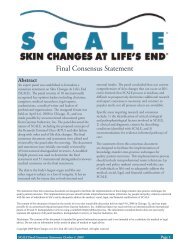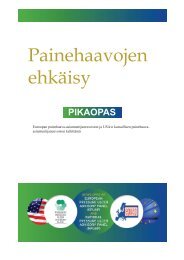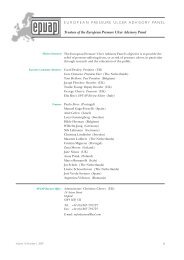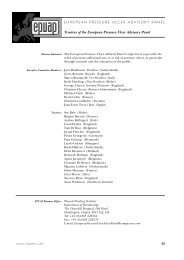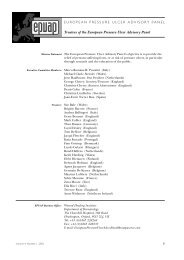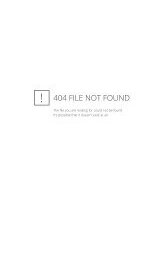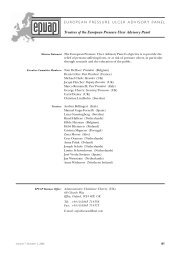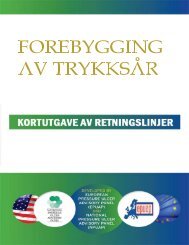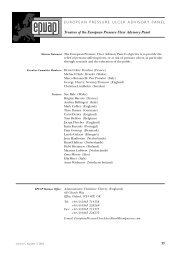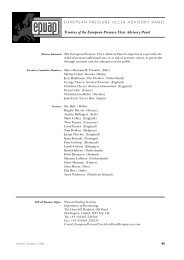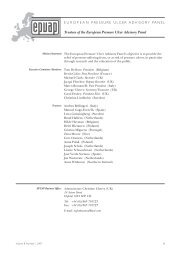Review 6.2 - European Pressure Ulcer Advisory Panel
Review 6.2 - European Pressure Ulcer Advisory Panel
Review 6.2 - European Pressure Ulcer Advisory Panel
You also want an ePaper? Increase the reach of your titles
YUMPU automatically turns print PDFs into web optimized ePapers that Google loves.
epuap<br />
EUROPEAN PRESSURE ULCER ADVISORY PANEL<br />
Abstracts<br />
ABSTRACTS FROM THE 2ND WORLD UNION OF<br />
WOUND HEALING SOCIETIES MEETING<br />
Paris, 8–13 July 2004<br />
PRESSURE ULCERS AND NUTRITION:<br />
A NEW EUROPEAN GUIDELINE<br />
M. Clark<br />
<strong>Pressure</strong> ulcers are frequently associated with malnutrition;<br />
however to what extent is this relationship valid The <strong>European</strong><br />
<strong>Pressure</strong> <strong>Ulcer</strong> <strong>Advisory</strong> <strong>Panel</strong> (EPUAP) has developed<br />
a new practice guideline addressing the role of nutrition in<br />
pressure ulcer prevention and treatment. This guideline<br />
highlights that currently there is no strong scientific evidence<br />
for a direct relationship between poor nutrition and<br />
the development of pressure ulcers, although it is possible<br />
that poor nutrition may influence the vulnerability of tissue<br />
to extrinsic factors such as pressure. Stronger links exist<br />
between malnutrition and the delayed healing of pressure<br />
ulcers. The new guideline was developed by a multidisciplinary<br />
group with members drawn from five <strong>European</strong><br />
countries. Much of the guideline was based on a new<br />
Cochrane review of the links between nutrition and pressure<br />
ulcers. The draft guideline was presented during the<br />
EPUAP Annual Conference in September 2003 and published<br />
in draft form in the EPUAP <strong>Review</strong> with the guideline<br />
revised in light of comments received. The final version<br />
of the guideline (available in eight <strong>European</strong> languages)<br />
covers the whole nutritional cycle and includes<br />
weighted recommendations with regard to nutritional<br />
screening, assessment, intervention, evaluation and followup.<br />
The guideline especially stresses the importance of integrating<br />
nutritional activities into daily pressure ulcer care.<br />
This presentation will discuss the development, content and<br />
implementation of the new guideline with implementation<br />
assisted through the development of a decision tree which<br />
can be used to aid the translation of the guideline into locally<br />
relevant protocols of care. The <strong>European</strong> <strong>Pressure</strong><br />
<strong>Ulcer</strong> <strong>Advisory</strong> <strong>Panel</strong> would like to thank Nutricia for an<br />
unrestricted educational grant that made development of<br />
the guideline possible. Members of the Guideline Development<br />
Group were Benati G, Clark M, Cohn D. Jackson P,<br />
Kerry B, Langer G and Schols JMGA.<br />
INTERRATER AND INTRARATER RELIABILITY<br />
OF THE EPUAP PRESSURE ULCER<br />
CLASSIFICATION SYSTEM<br />
T. Defloor, L. Schoonhoven<br />
Background: Correct identification and classification of a<br />
pressure ulcer is important for an accurate reporting of the<br />
magnitude of the problem, and for timely prevention. The<br />
reliability of classification systems has rarely been tested.<br />
Aims: To examine the interrater and intrarater reliability of<br />
classifying pressure ulcers according to the EPUAP classification<br />
system using pressure ulcer photographs.<br />
Design: Survey among nurses without special expertise in<br />
pressure ulcers.<br />
Methods: 56 photographs of normal skin, blanchable erythema,<br />
pressure ulcers (PU) or incontinence lesions were<br />
correctly classified by 53 PU experts. The photographs were<br />
presented in a random order to 473 nurses. A random selection<br />
of 9 photographs were included twice. 83 nurses<br />
did the test twice within a time interval of one month.<br />
Results: The interrater reliability (k = 0.37) and the intrarater<br />
reliability (k=052) were low. Incontinence lesions were confused<br />
most frequently with superficial PU; 80.2% of the PU<br />
lesions (grade 2 and higher~ were identified as such. Nurses<br />
who classified more photographs correctly, remained consistent<br />
in their judgement. Nurses with a limited number<br />
of correct answers, frequently changed from opinion in<br />
between two sessions.<br />
Conclusions: The interrater and intrarater-reliability of the<br />
EPUAP-classification appears to be low for the assessment<br />
by nurses with no special expertise in PU. More attention<br />
should be given to training in PU classification. The description<br />
of the different PU grades should be further developed,<br />
based on their clinical presentation and not only<br />
on the anatomic limits of soft tissue damage.<br />
OBSERVATION OF NON-BLANCHABLE<br />
ERYTHEMA<br />
K. Vander Wee, B. De Neve, M. Grypdonck, T. Defloor<br />
Introduction: The use of risk assessment scales is recommended<br />
to identify patients at risk for pressure ulcers. For<br />
many patients however, applying these scales results in an<br />
inefficient use of preventive measures. Recent research has<br />
shown that waiting until non-blanchable erythema occurs<br />
before starting prevention is a more efficient method than<br />
using the Braden scale. It is important that non-blanchable<br />
erythema is correctly observed. The aim of this study is to<br />
examine two methods to observe non-blanchable erythema<br />
and to examine the interrater reliability of the observations.<br />
Methods: 303 patients of an acute geriatric ward with erythema<br />
observed by the researcher participated in the study.<br />
Nurses observed heels, hips and sacrum daily. They scored<br />
48<br />
Volume 6, Number 2, 2004



